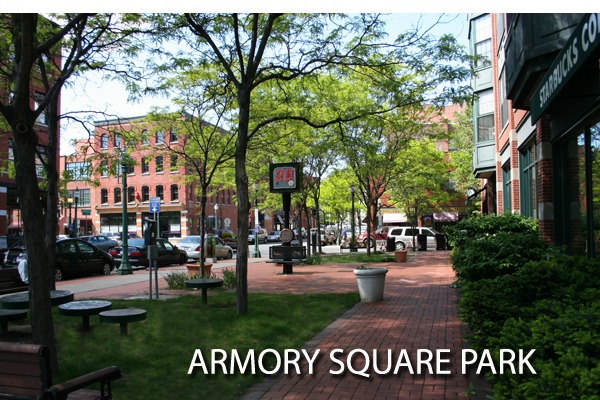LOCATION:
228 West Jefferson Street, 13202 (Intersection of Walton St. and S. Franklin St.)


GENERAL INFORMATION:
- Total Acerage: 1
- Type of Park: Downtown Park
- TNT Sector: Area 1 – Downtown
- Directions:
From the North: Interstate 81 southbound to Clinton St/Salina St., exit 19. Keep left at the fork, following signs for Salina St and merge onto N Salina St. (.4 mi). Turn right onto W Washington St. Take 2nd left onto S Franklin St. S. Franklin St runs into the heart of Armory Square.
From the South: Interstate 81 northbound to Adams St/Harrison St, exit 18. At the bottom of the ramp stay straight onto Almond St. First left onto Harrison St. (.1 mi). Drive on Harrison (.5 mi), turn right onto S. Salina. At the first light turn left onto W Jefferson St. When road splits stay to the right to continue on W Jefferson. This runs into S. Franklin St.
From the West: Interstate 690 eastbound to West St exit. Keep left at the fork and merge onto S West St. Turn left onto W Fayette St (.5 mi). Turn right onto S Franklin St. (.2 mi).
From the East: Interstate 690 westbound to West St, exit 11. Merge onto S West St. Turn left on W Fayette St (.3 mi). Turn right onto S Franklin St. (.2 mi).
FEATURES:
- 24- Second Shot Clock
RELATED INFORMATION:
USEFUL LINKS:
HISTORICAL INFORMATION:
Armory Square is a Public/Private Partnership between the City of Syracuse and the Armory Square Association. Armory Square was part of the historic Walton tract, and site of Walton’s millpond that fed a mill (1805) located on Genesee St. In 1849 the millpond and its surrounding swamp were filled in with soil from Prospect Hill, helping to eliminate frequent epidemics of malaria. The area was graded, existing streets extended, and the oval-shaped Jefferson Park, site of the first Armory (1859) and parade ground, was established.
The 1820’s brought the construction of the Erie Canal, and with the 1830’s came the railroads. These developments sparked business and building activities. Two railroad companies chose this location for the terminals, resulting in a concentration of hotels, boarding houses, shops, warehouses, and factories. The removal of the railroads from the streets of downtown Syracuse in the 1930’s brought a decline to the area. In the 1970’s a group of enterprising owners and artists became interested in Armory Square, which has since experienced a renaissance. In 1984, Armory Square was listed on the National Register of historic Places.
Architecturally the district’s structures exhibit the technological innovations and construction methods found in the commercial and architectural styles of the middle and late 1800’s and early 1900’s.

